|
|
|
|
Products mentioned in this Article
--None--
|
|
|
|
|
|
|
|
|
 |
|
|
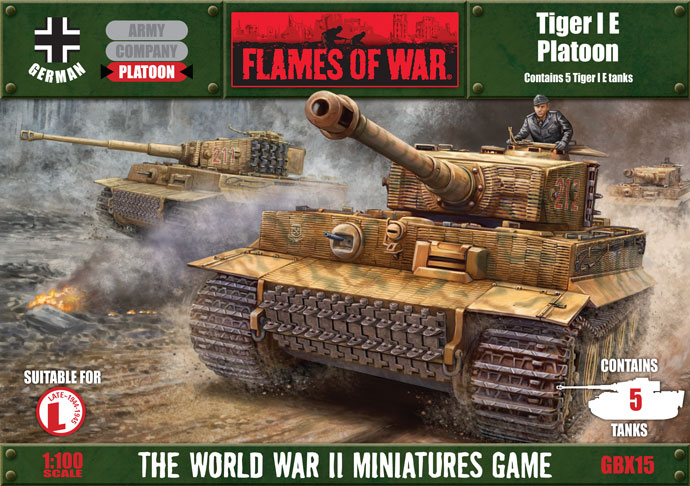 |
Tiger I E Platoon (GBX15)
includes five Individually sculpted Tiger I E tanks, five Tank Commanders, one German decal sheet & ten Rare earth magnets.
When the Tiger was introduced in 1942 it was a weapon un-equalled in
performance and protection, there was little the Allies in the Tunisia
or Russia could do to knock them out. It had its disadvantages (it was
slow and a little unreliable to start with), but at the time its clear
advantages outweighed these.
Check out the Tiger I E Platoon in the online store here...
|
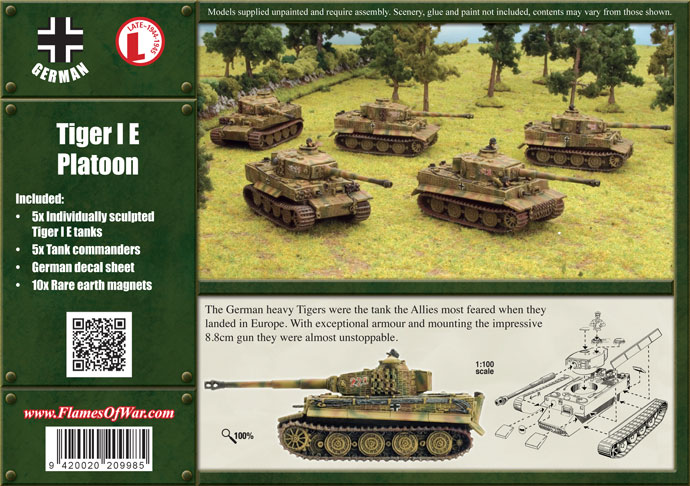 |
The Tiger first underwent development when
specifications for a new heavy tank were sent out to various
manufacturers. It was to mount a gun that penetrated 100mm of armour at a
1500m and also be able to withstand return fire from similar weapons.
Henschel developed the VK3601, but this design was to have a squeeze
bore weapon, which had to be abandoned due to the lack of an adequate
supply of tungsten for the ammunition. The VK3601 was quickly adapted to
mount the 8.8cm KwK36 gun, which had already made itself famous in the
anti-tank role as the FlaK 36.
The new prototype became the VK4501 (H), the (H) to distinguish it
from the parallel development of Porsche VK4501 (P) (which later became
the Ferdinand). |
The order to start the final design was issued on 26 May 1941. Henschel
was to develop the chassis while Krupp developed the turret. Porsche’s
version was also still under development and Krupp was also to provide
the turret for this. Rheinmetall also developed a turret mounting the
7.5cm KwK L/70 gun (later to become famous as the Panther’s gun) but
this was abandoned in favour of the 8.8cm mounts.
|
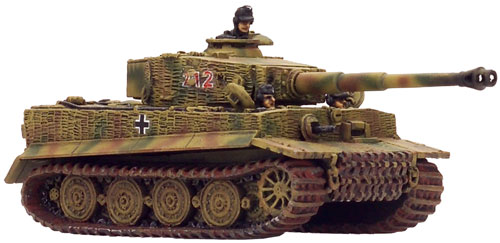 |
| Production of the Tiger I E began in July 1942. Production of the
Porsche model was abandoned after problems with the engines and
suspension and only five tanks were completed. The Henschel model now
became the sole Tiger in production. The target was to produce 285 by 12
May 1943 in time for the summer offensive. |
| The Production model Henschel Tiger I E had 100mm
of front armour on both its hull and turret, 80mm on its rear and sides,
and 25mm of top armour. None of the armour was particularly well
sloped, but it had lots of it. It 8.8cm gun had already proved itself in
combat as a lethal anti-armour weapon. |
| The first Tigers issued went to the newly
assembled men of 502nd Schwere Panzerabteilung, who were quickly sent to
the Leningrad front in August 1942. Tigers also made an appearance in
North Africa in late 1942, much to the disturbance of the allied
soldiers who ran into them, many of the legends surrounding the Tiger
spring from these first encounters. |
| The Tigers of the SS Divisions and Grossdeutschland also made their
impact felt during the Battle of Kursk, taking a terrible toll on the
once mighty T-34, now equalled by the up gunned Panzer IV and by far out
ranked by the Panther and Tiger. |
| The Tiger underwent couple of upgrades during its
life; in July 1943 the cupola was changed to a new design with
periscopes and a rotating hatch similar to the Panther. May 1943 saw the
introduction of a new engine to improved performance, and in January
1944 a new road wheel was introduced. |
The Tiger I E success as a design can be marked by its
continued destructive use in the hand of aces like Michael Wittmann and
Otto Carius right until the end of the war.
Designed by Evan Allen
Painted by Jeremy Painter |
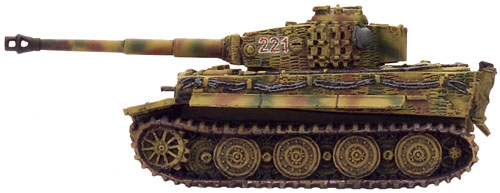 |
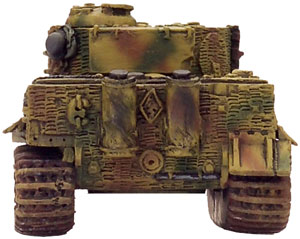 |
| The Tiger I E in Flames Of War |
| |
|
|
Armour
|
|
|
Name
|
Mobility
|
Front
|
Side
|
Top
|
Equipment and Notes
|
Weapon
|
Range
|
ROF
|
Anti-tank
|
Firepower
|
|
Tiger I E
|
Slow Tank
|
9
|
8 |
2
|
Co-ax MG, Hull MG, Protected ammo, Wide tracks. |
8.8cm KwK36 gun
|
40"/100cm
|
2
|
13
|
3+
|
Slow traverse.
|
|
Protected Ammo
Many tanks are destroyed not by the enemy shell but by their own
ammunition being hit by white-hot fragments of armour and exploding. The
chances of this were minimised by providing a safe place for stowing
ammunition within the vehicle such as an armoured compartment or inside a
water-filled jacket.
If forced to bail out, crews of tanks with protected ammunition
are far more confident when it comes to remounting their vehicle
quickly.
Tanks with Protected Ammo re-roll all failed Motivation Tests to
Remount Bailed Out vehicles in the Starting Step (see page 102 of the
main rulebook). |
Wide Tracks
Some excellent tank designs have successfully utilised wider tracks, allowing them to cross almost any terrain.
If a vehicle with Wide Tracks becomes Bogged Down while
attempting to cross Rough Terrain, roll again. On a roll of 4+ the
vehicle immediately frees itself and continues moving. |
Slow Traverse
Most tanks were either fitted with power traverse or had turrets that
were light enough to be quickly swung by hand. Some designs suffered
from heavy turrets lacking power traverse.
Tanks with slow traverse add +1 to the score required to hit when
shooting any turret-mounted weapon except an AA MG at targets that are
entirely behind a line drawn across the front of the tank’s turret
before they rotate their turret to face the target. |
| Contents & Assembly Guide Coming Soon... |
Last Updated On Thursday, March 6, 2014 by Blake at Battlefront
|
|
|